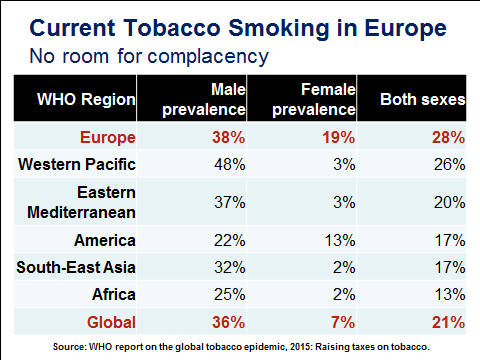Data and statistics

Tobacco use is the single most preventable cause of death and disease. Among the WHO regions, Europe has the highest prevalence of tobacco smoking among adults (28%) and some of the highest prevalence of tobacco use by adolescents.
Tobacco control is a primary entry point for achieving the global goal, agreed upon by the World Health Assembly in 2013, of a 25% reduction in premature mortality from noncommunicable diseases (NCDs) by 2025. One of the nine voluntary global targets that were also endorsed by the World Health Assembly refers to a 30% relative reduction in prevalence of current tobacco use in persons aged 15+ years by 2025.
Health has a central place in United Nations Sustainable Development Goal (SDG) 3 – "Ensure healthy lives and promote well-being for all at all ages" – one of the 17 SDGs that all UN Member States collectively aim to achieve by the year 2030. Target 3.a of SDG 3 refers particularly to strengthening the implementation of the WHO Framework Convention on Tobacco Control (WHO FCTC) in all countries.
Tobacco use among adults
While tobacco use was previously largely a male phenomenon, the gap in prevalence between male and female adults is now very small (<5%) in countries such as Denmark, Ireland, the Netherlands, Norway, Sweden and the United Kingdom.
The WHO report on the global tobacco epidemic, 2015, shows that 19% of women aged 15 and above in the WHO European Region smoked tobacco in 2013. This is a high average compared to those for women in the WHO African, South-East Asia, Eastern Mediterranean and Western Pacific Regions (2–3%).
WHO has projected that the prevalence level in 2025 among males will be 31% and among females it will be 16%. Taking the years from 2010 to 2025, this means a projected relative reduction of 22% among the male population, and of 25% among the female population. The WHO European Region would thus need to accelerate its efforts in tobacco control in order to achieve the global target of a 30% relative reduction by 2025.
Tobacco use among adolescents
Tobacco use among adolescents is increasing in the Region, and in some countries (e.g., Czech Republic, Latvia or Lithuania) tobacco use among youth is very similar to that among adults. According to the 2013/2014 round of the Health Behaviour in School-aged Children (HBSC) study, the percentage of boys who smoked at least once a week at the age of 15 years old ranges from a low of 5% in Armenia to a high of 51% in Greenland. The percentage of girls who smoked at least once a week at the age of 15 years old ranges from 1% in Armenia to53% in Greenland. The average for all countries represented in the report was 12% for boys and 11% for girls.
Deaths attributed to tobacco
Compared to the rest of the world, the WHO European Region has one of the highest proportions of deaths attributable to tobacco use (smoking and smokeless). WHO has estimated that tobacco use is currently responsible for 16% of all deaths in adults over 30 in the Region, with many of these deaths occurring prematurely. This is in contrast to the African or the Eastern Mediterranean Regions, with 3% and 7% proportion of tobacco-attributable deaths, respectively, and with the global average of 12%.
Implementation of the WHO FCTC
The WHO FCTC is a powerful legal instrument to help fight the tobacco epidemic. The WHO European Region has made great advances in the implementation of this Treaty, which has been ratified by 50 out of 53 countries. However, full implementation of the Treaty and most of its obligations still remains low. For example:
- Out of the countries that have ratified the WHO FCTC, only 29 have raised taxes to the point where excise taxes account for at least 75% of the retail prices of tobacco products.
- Only 10 countries have introduced comprehensive bans to make all public places completely smoke-free.
- Eight countries offer at least three types of clinical cessation interventions (national quit line, as well as both nicotine replacement therapy and some cessation services, with costs covered).
- Four countries have a comprehensive ban on all forms of direct and indirect advertising of tobacco products and three countries require large pictorial health warning labels on cigarette packages with all appropriate characteristics.
For more information on implementation of the WHO FCTC, see the link below.



